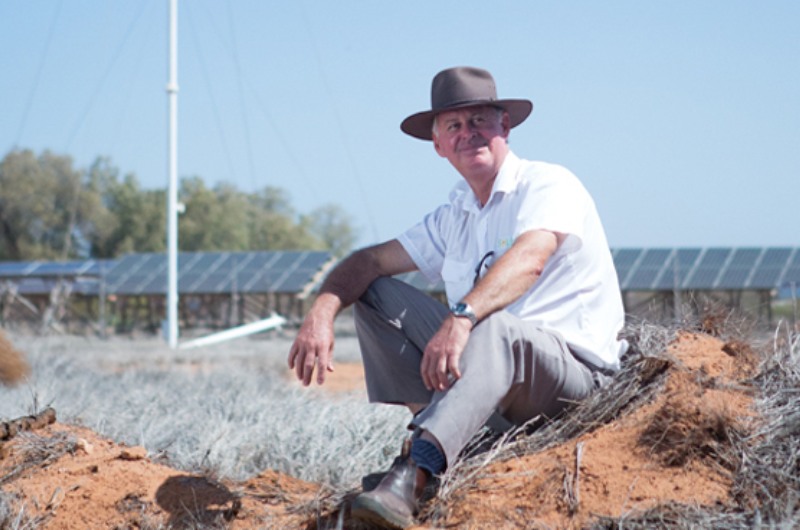How Counting on U is transforming accounting
The origin of the Counting on U Project stems from the CEO of the IPA, Andrew Conway – who said “The biggest issue...
READ MORE
Lex Fullarton jokes that he’s the only truck driver in Australia with a PhD in taxation. One thing is certain: he’s the only accountant making ice from the sun on a rugged backblock in Carnarvon, nearly 1,000 kilometres north of Perth, where the Gascoyne River spills into the Indian Ocean.

Fullarton, a fourth-generation Scottish-Australian with a love of the bush and a penchant for wearing kilts and using colourful language, is a "solar ice farmer" – harnessing energy from the sun to power his ice factory in the searing West Australian heat.
[fastfacts][fastfacts_title]View Lex's vital stats:[/fastfacts_title][fastfacts_content]
Name: Lex Fullarton
Company: Solex Carnarvon Solar Farm
IPA Status: Fellow
Location: Carnarvon, WA
[/fastfacts_content][/fastfacts]
The story of just how an accountant ended up running an ice factory and championing the use of solar power all began with a barren pocket of land that had been disused for six decades after years as a parking lot for wool-hauling camels.
When Fullarton won ownership of the four-hectare block in 1997, it stretched from a "dead prickle bush in one corner to a disused rabbit warren and a sun-whitened sheep’s skull in another".
The scorched clay pan didn’t exactly charm Fullarton’s wife. "She looked around, suitably impressed, and said, ‘can you … give it back?’".
Not exactly. But as a tax agent, Fullarton knew he’d need to make an income from it so that the annual rates didn’t become a burden.
"I thought ‘what in the far out am I going to produce on a sun-baked piece of [crap] like this?’ Then it came to me … there is another thing that Carnarvon is famous for." That ‘thing’ was being a NASA tracking station for around a decade from 1964.
Fullarton figured that if spaceships from three NASA programs (Gemini, Apollo and Skylab) could be tracked from the mango and banana growing region, why couldn’t the sun – and with about 211 clear days a year and average daytime July temperatures of 22 degrees, Carnarvon gets plenty of that.
Although solar power was hardly a new concept, it was at that time an energy-harnessing technology so little used in Australia that Fullarton had to contact experts in Texas to engineer his
array. The design allows solar panels to be secured into cyclone-resistant positions that enable them to cope with the damaging winds that can hammer the Gascoyne region, and to be tilted to make the most of the sun at different times of the year.
Using his bush know-how – acquired from jackerooing on vast stations when he was a teenager – Fullarton and his son were able to build Western Australia’s first commercial solar farm, albeit one constrained by the local power company’s lack of willingness to have solar power fed into its grid.
When it came online in 2003, the plant could produce 15 kilowatts (kW) of energy per hour at peak output. That’s a modest output considering that a 102 megawatt solar farm is now under construction in central New South Wales and that Carnarvon itself now has a 290kW farm; a decade ago, however, solar power was quite a contentious issue. The local shire president even labelled Fullarton a ‘fruit loop’, spawning a new name for Carnarvon folk who took up solar.
"The Carnarvon Fruit Loops kicked off and you got a number depending on [when] you switched on," says Fullarton. "We have now got nearly 10 per cent of Carnarvon’s electricity draw coming from solar PV [photovoltaics]."
In a twist, the chief Fruit Loop last year joined his critics after being voted onto the Shire of Carnarvon – Fullarton’s first foray into local government.
More than a decade after it was switched on, Fullarton’s farm can generate up to 61.5kW of electricity per hour – drawing 46kW from solar and 15.5 kW from wind. And in 2009, Fullarton was inspired to value-add by building the ice factory.
Fullarton and his wife Julie, along with Bertie the bagging machine – imported all the way from Texas – now churn out nearly a tonne of ice a day.
"I wasn’t intending to take over the manufacture of the entire ice production for the Gascoyne region, but that is what has happened," says Fullarton.
"People who generate what I call ‘black ice’ [using coal-fired power] – they can’t compete because they are manufacturing in Geraldton [about 480 kilometres] south of here and then they have to transport it up in freezer trucks. Of course, they need the diesel to run the freezer, the diesel to run the trucks, and by the time they have paid for the electricity to freeze the water and drag it all the way up here, it is just not viable."